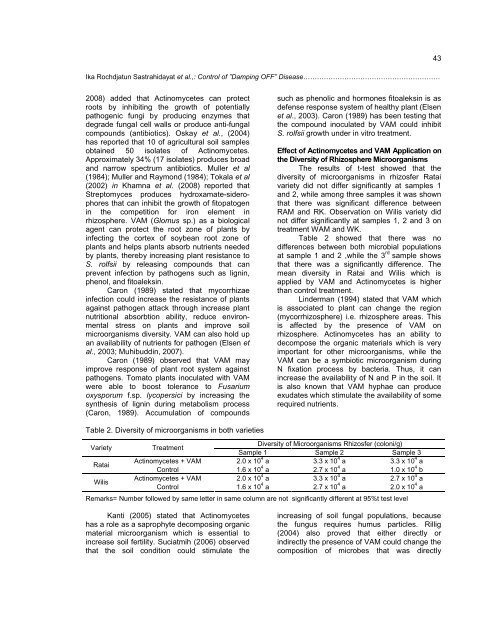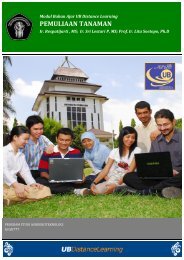CONTROL OF “DAMPING OFF” DISEASE CAUSED BY Sclerotium ...
CONTROL OF “DAMPING OFF” DISEASE CAUSED BY Sclerotium ...
CONTROL OF “DAMPING OFF” DISEASE CAUSED BY Sclerotium ...
Create successful ePaper yourself
Turn your PDF publications into a flip-book with our unique Google optimized e-Paper software.
Ika Rochdjatun Sastrahidayat et al.,: Control of ”Damping <strong>OF</strong>F” Disease……………………………………………………<br />
2008) added that Actinomycetes can protect<br />
roots by inhibiting the growth of potentially<br />
pathogenic fungi by producing enzymes that<br />
degrade fungal cell walls or produce anti-fungal<br />
compounds (antibiotics). Oskay et al., (2004)<br />
has reported that 10 of agricultural soil samples<br />
obtained 50 isolates of Actinomycetes.<br />
Approximately 34% (17 isolates) produces broad<br />
and narrow spectrum antibiotics. Muller et al<br />
(1984); Muller and Raymond (1984); Tokala et al<br />
(2002) in Khamna et al. (2008) reported that<br />
Streptomyces produces hydroxamate-siderophores<br />
that can inhibit the growth of fitopatogen<br />
in the competition for iron element in<br />
rhizosphere. VAM (Glomus sp.) as a biological<br />
agent can protect the root zone of plants by<br />
infecting the cortex of soybean root zone of<br />
plants and helps plants absorb nutrients needed<br />
by plants, thereby increasing plant resistance to<br />
S. rolfsii by releasing compounds that can<br />
prevent infection by pathogens such as lignin,<br />
phenol, and fitoaleksin.<br />
Caron (1989) stated that mycorrhizae<br />
infection could increase the resistance of plants<br />
against pathogen attack through increase plant<br />
nutritional absorbtion ability, reduce environmental<br />
stress on plants and improve soil<br />
microorganisms diversity. VAM can also hold up<br />
an availability of nutrients for pathogen (Elsen et<br />
al., 2003; Muhibuddin, 2007).<br />
Caron (1989) observed that VAM may<br />
improve response of plant root system against<br />
pathogens. Tomato plants inoculated with VAM<br />
were able to boost tolerance to Fusarium<br />
oxysporum f.sp. lycopersici by increasing the<br />
synthesis of lignin during metabolism process<br />
(Caron, 1989). Accumulation of compounds<br />
Table 2. Diversity of microorganisms in both varieties<br />
43<br />
such as phenolic and hormones fitoaleksin is as<br />
defense response system of healthy plant (Elsen<br />
et al., 2003). Caron (1989) has been testing that<br />
the compound inoculated by VAM could inhibit<br />
S. rolfsii growth under in vitro treatment.<br />
Effect of Actinomycetes and VAM Application on<br />
the Diversity of Rhizosphere Microorganisms<br />
The results of t-test showed that the<br />
diversity of microorganisms in rhizosfer Ratai<br />
variety did not differ significantly at samples 1<br />
and 2, while among three samples it was shown<br />
that there was significant difference between<br />
RAM and RK. Observation on Wilis variety did<br />
not differ significantly at samples 1, 2 and 3 on<br />
treatment WAM and WK.<br />
Table 2 showed that there was no<br />
differences between both microbial populations<br />
at sample 1 and 2 ,while the 3 rd sample shows<br />
that there was a significantly difference. The<br />
mean diversity in Ratai and Wilis which is<br />
applied by VAM and Actinomycetes is higher<br />
than control treatment.<br />
Linderman (1994) stated that VAM which<br />
is associated to plant can change the region<br />
(mycorrhizosphere) i.e. rhizosphere areas. This<br />
is affected by the presence of VAM on<br />
rhizosphere. Actinomycetes has an ability to<br />
decompose the organic materials which is very<br />
important for other microorganisms, while the<br />
VAM can be a symbiotic microorganism during<br />
N fixation process by bacteria. Thus, it can<br />
increase the availability of N and P in the soil. It<br />
is also known that VAM hyphae can produce<br />
exudates which stimulate the availability of some<br />
required nutrients.<br />
Variety Treatment<br />
Diversity of Microorganisms Rhizosfer (coloni/g)<br />
Sample 1 Sample 2 Sample 3<br />
Actinomycetes + VAM 2.0 x 10 4 a 3.3 x 10 4 a 3.3 x 10 4 Ratai<br />
Control 1.6 x 10<br />
a<br />
4 a 2.7 x 10 4 a 1.0 x 10 4 b<br />
Actinomycetes + VAM 2.0 x 10 4 a 3.3 x 10 4 a 2.7 x 10 4 Wilis<br />
Control 1.6 x 10<br />
a<br />
4 a 2.7 x 10 4 a 2.0 x 10 4 a<br />
Remarks= Number followed by same letter in same column are not significantly different at 95%t test level<br />
Kanti (2005) stated that Actinomycetes<br />
has a role as a saprophyte decomposing organic<br />
material microorganism which is essential to<br />
increase soil fertility. Suciatmih (2006) observed<br />
that the soil condition could stimulate the<br />
increasing of soil fungal populations, because<br />
the fungus requires humus particles. Rillig<br />
(2004) also proved that either directly or<br />
indirectly the presence of VAM could change the<br />
composition of microbes that was directly




